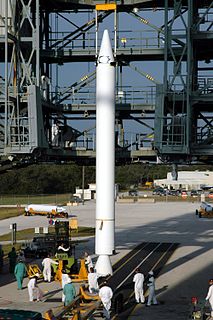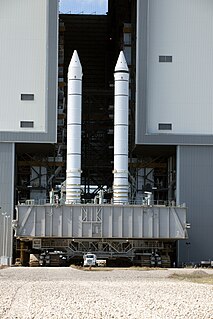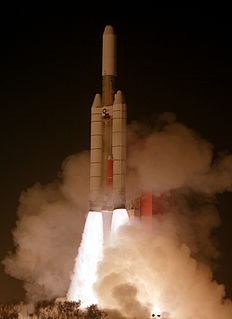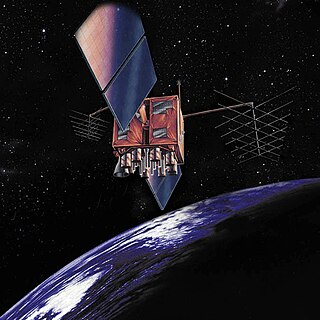Related Research Articles

The Space Shuttle was a partially reusable low Earth orbital spacecraft system operated from 1981 to 2011 by the U.S. National Aeronautics and Space Administration (NASA) as part of the Space Shuttle program. Its official program name was Space Transportation System (STS), taken from a 1969 plan for a system of reusable spacecraft where it was the only item funded for development. The first of four orbital test flights occurred in 1981, leading to operational flights beginning in 1982. Five complete Space Shuttle orbiter vehicles were built and flown on a total of 135 missions from 1981 to 2011, launched from the Kennedy Space Center (KSC) in Florida. Operational missions launched numerous satellites, interplanetary probes, and the Hubble Space Telescope (HST), conducted science experiments in orbit, participated in the Shuttle-Mir program with Russia, and participated in construction and servicing of the International Space Station (ISS). The Space Shuttle fleet's total mission time was 1,322 days, 19 hours, 21 minutes and 23 seconds.

Titan was a family of United States expendable rockets used between 1959 and 2005. The Titan I and Titan II were part of the US Air Force's intercontinental ballistic missile fleet until 1987. The space launch vehicle versions contributed the majority of the 368 Titan launches, including all the Project Gemini crewed flights of the mid-1960s. Titan vehicles were also used to lift US military payloads as well as civilian agency reconnaissance satellites and to send interplanetary scientific probes throughout the Solar System.

A booster rocket is either the first stage of a multistage launch vehicle, or else a shorter-burning rocket used in parallel with longer-burning sustainer rockets to augment the space vehicle's takeoff thrust and payload capability. Boosters are traditionally necessary to launch spacecraft into low Earth orbit, and are especially important for a space vehicle to go beyond Earth orbit. The booster is dropped to fall back to Earth once its fuel is expended, a point known as booster engine cut-off (BECO).

The Space Shuttle Challenger disaster was a fatal incident in the United States' space program that occurred on January 28, 1986, when the Space ShuttleChallenger (OV-099) broke apart 73 seconds into its flight, killing all seven crew members aboard. The crew consisted of five NASA astronauts, and two payload specialists. The mission carried the designation STS-51-L and was the tenth flight for the Challenger orbiter.

Delta II was an expendable launch system, originally designed and built by McDonnell Douglas. Delta II was part of the Delta rocket family and entered service in 1989. Delta II vehicles included the Delta 6000, and the two later Delta 7000 variants. The rocket flew its final mission ICESat-2 on 15 September 2018, earning the launch vehicle a streak of 100 successful missions in a row, with the last failure being GPS IIR-1 in 1997.

The Space Shuttle Solid Rocket Booster was the first solid-propellant rocket to be used for primary propulsion on a vehicle used for human spaceflight and provided the majority of the Space Shuttle's thrust during the first two minutes of flight. After burnout, they were jettisoned and parachuted into the Atlantic Ocean where they were recovered, examined, refurbished, and reused.

The Defense Meteorological Satellite Program (DMSP) monitors meteorological, oceanographic, and solar-terrestrial physics for the United States Department of Defense. The program is managed by the United States Space Force with on-orbit operations provided by the National Oceanic and Atmospheric Administration (NOAA). The mission of the satellites was revealed in March 1973. They provide cloud cover imagery from polar orbits that are Sun-synchronous at nominal altitude of 830 km (520 mi).

Titan IV was a family of heavy-lift space launch vehicles developed by Martin Marietta and operated by the United States Air Force from 1989 to 2005. Launches were conducted from Cape Canaveral Air Force Station, Florida and Vandenberg Air Force Base, California.

Titan IIIB was the collective name for a number of derivatives of the Titan II ICBM and Titan III launch vehicle, modified by the addition of an Agena upper stage. It consisted of four separate rockets. The Titan 23B was a basic Titan II with an Agena upper stage, and the Titan 24B was the same concept, but using the slightly enlarged Titan IIIM rocket as the base. The Titan 33B was a Titan 23B with the Agena enclosed in an enlarged fairing, in order to allow larger payloads to be launched. The final member of the Titan IIIB family was the Titan 34B which was a Titan 24B with the larger fairing used on the Titan 33B.

The Titan IIIC was an expendable launch system used by the United States Air Force from 1965 until 1982. It was the first Titan booster to feature large solid rocket motors and was planned to be used as a launcher for the Dyna-Soar, though the spaceplane was cancelled before it could fly. The majority of the launcher's payloads were DoD satellites, for military communications and early warning, though one flight (ATS-6) was performed by NASA. The Titan IIIC was launched exclusively from Cape Canaveral while its sibling, the Titan IIID, was launched only from Vandenberg AFB.

Project Gemini was NASA's second human spaceflight program. Conducted between projects Mercury and Apollo, Gemini started in 1961 and concluded in 1966. The Gemini spacecraft carried a two-astronaut crew. Ten Gemini crews and sixteen individual astronauts flew low Earth orbit (LEO) missions during 1965 and 1966.
Jumpseat, also known as AFP-711 is reportedly a code name for a class of SIGINT reconnaissance satellites operated by the National Reconnaissance Office for the United States Air Force in the 1970s and 1980s. The program is classified, and much of the information in the open is speculative.
Canyon was a series of seven United States spy satellites launched between 1968 and 1977. Also known by its program number AFP-827, the satellites were developed with the participation of the Air Force. The Canyon project is credited as being the first American satellite system tasked for COMINT.

The Castor family of solid-fuel rocket stages and boosters built by Thiokol and used on a variety of launch vehicles. They were initially developed as the second-stage motor of the Scout rocket. The design was based on the MGM-29 Sergeant, a surface-to-surface missile developed for the United States Army at the Jet Propulsion Laboratory.
TRUMPET is reportedly a series of ELINT reconnaissance satellites launched by the United States during the 1990s to replace the Jumpseat satellites. Speculated to weigh 5,200 kg, three of these satellites were launched into highly elliptical (Molniya) orbits by Titan 4 launch vehicles from Cape Canaveral between 1994 and 1997. Their precise mission and capabilities are classified. News reports state that the satellites monitor radio communication using antennas with diameters of 150 m. It is speculated that the satellites are manufactured by Boeing.

Orion, also known as Mentor or Advanced Orion, is a class of United States spy satellites that collect signals intelligence (SIGINT) from space. Operated by the National Reconnaissance Office (NRO) and developed with input from the Central Intelligence Agency (CIA), eight have been launched from Cape Canaveral on Titan IV and Delta IV launch vehicles since 1995.

The Titan 34D was a United States expendable launch vehicle used to launch a number of satellites for military applications.

GPS IIR-1 or GPS SVN-42 was the first Block IIR GPS satellite to be launched. It was to have been operated as part of the United States Air Force Global Positioning System. It was launched on 17 January 1997, and was destroyed 13 seconds into its flight due to a malfunction of the Delta II launch vehicle that was carrying it. It was estimated to have cost US$40 million, with its launch vehicle costing US$55 million. The satellite that was used for the GPS IIR-1 mission was the second production IIR satellite, SVN-42.

Vortex, previously known as Chalet, was a class of spy satellite operated by the United States during the 1980s and 1990s to collect signals intelligence (SIGINT) from high Earth orbit. The Vortex satellites were operated by the National Reconnaissance Office for the United States Air Force and listened to radio transmissions originating from Earth or space. The intercepted data is believed to have been fed into and analyzed by the National Security Agency ECHELON system.
References
- ↑ "Titan IVA-20 Accident Investigation Board Summary".
- ↑ "Archived copy". Archived from the original on 2009-05-04. Retrieved 2009-05-04.CS1 maint: archived copy as title (link)
- ↑ Craig Covault and Joseph C. Anselmo (1998-08-17). "Titan explosion destroys secret 'Mercury' sigint". Aviation Week and Space Technology. 149.